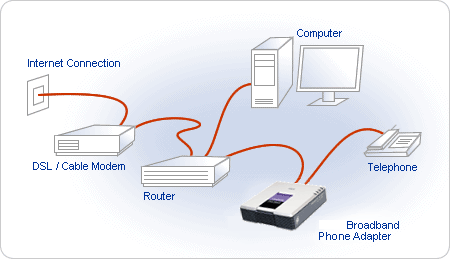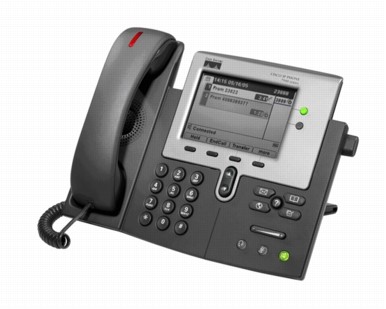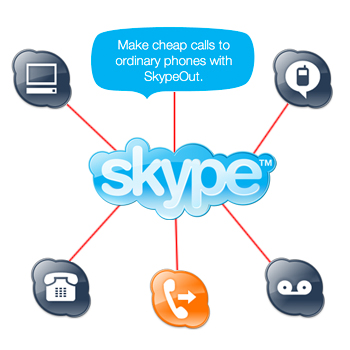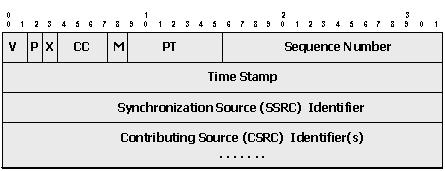VoIP
From Computing and Software Wiki
m (New page: '''Voice over Internet Protocol (VoIP) ''' is a general term for a family of technologies that convert analog audio signals (voice) to digital data that is then transmitted over an IP netw...) |
m |
||
| Line 5: | Line 5: | ||
The ATA is an analog to digital converter that connects a standard phone with the internet connection. It converts the analog signal from the phone and converts it to a digital signal that can pr transmitted over the internet. | The ATA is an analog to digital converter that connects a standard phone with the internet connection. It converts the analog signal from the phone and converts it to a digital signal that can pr transmitted over the internet. | ||
| + | [[Image:ATA.gif]] | ||
===VoIP Phones=== | ===VoIP Phones=== | ||
These phones allow a direct connection to the IP Network via Ethernet of Wi-Fi technology. Therefore, they allow the use of VoIP without the use of computer. There are two types of VoIP Phones: IP Phones and Wi-Fi phones. IP Phones have a different connector than regular phones. This connector (RJ-45 connector) allows it to link directly with the router via an Ethernet cable. Wi-Fi phones allow the VoIP calls with connection from any Wi-Fi hotspot. The Cisco IP Phone is a common example that is used in many companies. | These phones allow a direct connection to the IP Network via Ethernet of Wi-Fi technology. Therefore, they allow the use of VoIP without the use of computer. There are two types of VoIP Phones: IP Phones and Wi-Fi phones. IP Phones have a different connector than regular phones. This connector (RJ-45 connector) allows it to link directly with the router via an Ethernet cable. Wi-Fi phones allow the VoIP calls with connection from any Wi-Fi hotspot. The Cisco IP Phone is a common example that is used in many companies. | ||
| + | [[Image:Cisco IP Phone CP-7941G.jpeg]] | ||
===Computer – to – Computer=== | ===Computer – to – Computer=== | ||
In this case, VoIP software is installed on a computer and is used in conjunction with the computers microphone, speaker, sound card and internet connection. Skype is a common example of Computer-to-Computer VoIP technology. | In this case, VoIP software is installed on a computer and is used in conjunction with the computers microphone, speaker, sound card and internet connection. Skype is a common example of Computer-to-Computer VoIP technology. | ||
| - | + | [[Image:Skype.jpg]] | |
==How Does VoIP Work== | ==How Does VoIP Work== | ||
| Line 38: | Line 40: | ||
For real time transmission, the re-ordering and jitter issues are more important than the loss of packets. It does not matter if a few packets are lost as long as most of them arrive continuously and in order. Therefore, the error checking and retransmission scheme of TCP is not really suitable for this purpose. UDP provides the high speeds required for real time transmission. | For real time transmission, the re-ordering and jitter issues are more important than the loss of packets. It does not matter if a few packets are lost as long as most of them arrive continuously and in order. Therefore, the error checking and retransmission scheme of TCP is not really suitable for this purpose. UDP provides the high speeds required for real time transmission. | ||
| + | [[Image:RTP.jpg]] | ||
| + | |||
| + | The fields relevant to VoIP transmission include: | ||
| + | |||
| + | '''PT (Payload Type):''' This is a 7 bit field that allows values between 0 and 127. The interval between 96 and 127 is reserved for dynamic payload types. These are negotiated by the signaling protocol (SIPR or H.323) used to establish the VoIP call. | ||
| + | |||
| + | '''Sequence Number:''' This is a 16 bit value that helps order the packets after transmission. The sequence number starts at a random value and is incremented with each RTP packet sent | ||
| + | |||
| + | '''Timestamp:''' This is a 32 bit value that represents the clock tick count when the first audio sample in the payload was sampled. The timestamp also starts at a random value and incremented with each RTP packet sent. | ||
| + | |||
| + | '''Synchronization Source Identifier (SSRC):''' This is a 32 bit identifier that is chosen randomly and used to detect and resolve collisions. No two synchronization sources within the same RTP session will have the same SSRC. | ||
Revision as of 03:32, 6 April 2009
Voice over Internet Protocol (VoIP) is a general term for a family of technologies that convert analog audio signals (voice) to digital data that is then transmitted over an IP network such as the Internet.
Contents |
Types of VoIP Calls
Analog Telephone Adapter
The ATA is an analog to digital converter that connects a standard phone with the internet connection. It converts the analog signal from the phone and converts it to a digital signal that can pr transmitted over the internet.

VoIP Phones
These phones allow a direct connection to the IP Network via Ethernet of Wi-Fi technology. Therefore, they allow the use of VoIP without the use of computer. There are two types of VoIP Phones: IP Phones and Wi-Fi phones. IP Phones have a different connector than regular phones. This connector (RJ-45 connector) allows it to link directly with the router via an Ethernet cable. Wi-Fi phones allow the VoIP calls with connection from any Wi-Fi hotspot. The Cisco IP Phone is a common example that is used in many companies.

Computer – to – Computer
In this case, VoIP software is installed on a computer and is used in conjunction with the computers microphone, speaker, sound card and internet connection. Skype is a common example of Computer-to-Computer VoIP technology.

How Does VoIP Work
There are essentially seven stages to a VoIP transmission
- First the analog voice must be converted to a digital signal via an analog-to-digital converter
- The digital signal must be compressed for transmission
- The voice packets are then inserted into data packets using a real-time protocol (RTP)
- A signaling protocol is then required to call a user
- When the packet reaches the destination it must be disassembled
- The data is then extracted or decompressed
- The digital signal is then converted back to an analog voice signal via a digital to analog converter
Analog to Digital Conversion
Two factors play an important role in the successful digitization of an analog voice signal:
- Quantization: This refers the number of bits used to represent each sample. Audio signals are best represented by 16 bit samples.
- Sampling rate: This refers to the number of samples per second used to encode the sound. 8 kHz is the most common sampling frequency used to VoIP communication.
Real Time Protocol
After the data is converted into the correct format it is encapsulated in RTP Packets to be transmitted over the network. This transmission protocol needs to consider the following situations:
- The re-ordering of packets during the transmission
- The loss of packets
- The time between packet arrival (jitter)
For real time transmission, the re-ordering and jitter issues are more important than the loss of packets. It does not matter if a few packets are lost as long as most of them arrive continuously and in order. Therefore, the error checking and retransmission scheme of TCP is not really suitable for this purpose. UDP provides the high speeds required for real time transmission.

The fields relevant to VoIP transmission include:
PT (Payload Type): This is a 7 bit field that allows values between 0 and 127. The interval between 96 and 127 is reserved for dynamic payload types. These are negotiated by the signaling protocol (SIPR or H.323) used to establish the VoIP call.
Sequence Number: This is a 16 bit value that helps order the packets after transmission. The sequence number starts at a random value and is incremented with each RTP packet sent
Timestamp: This is a 32 bit value that represents the clock tick count when the first audio sample in the payload was sampled. The timestamp also starts at a random value and incremented with each RTP packet sent.
Synchronization Source Identifier (SSRC): This is a 32 bit identifier that is chosen randomly and used to detect and resolve collisions. No two synchronization sources within the same RTP session will have the same SSRC.
